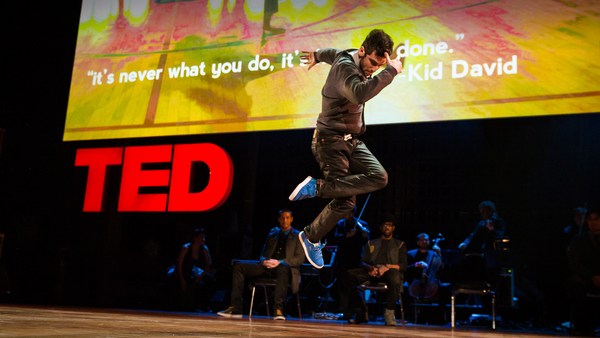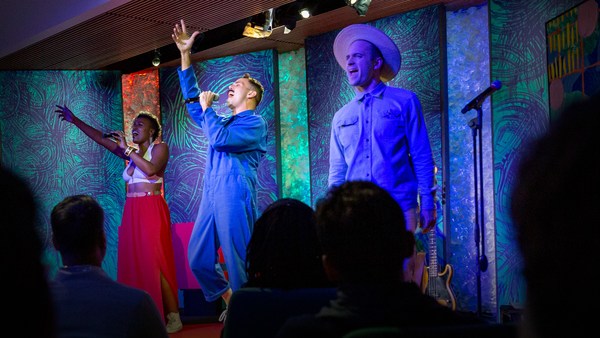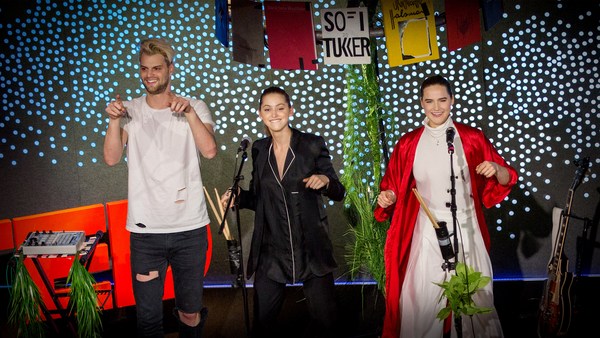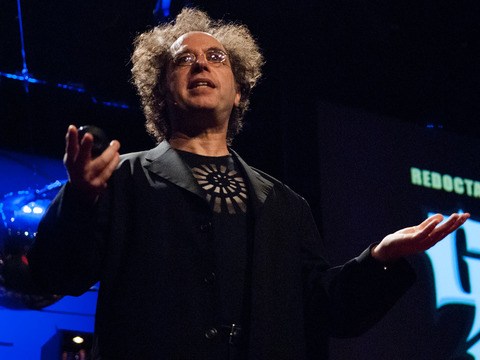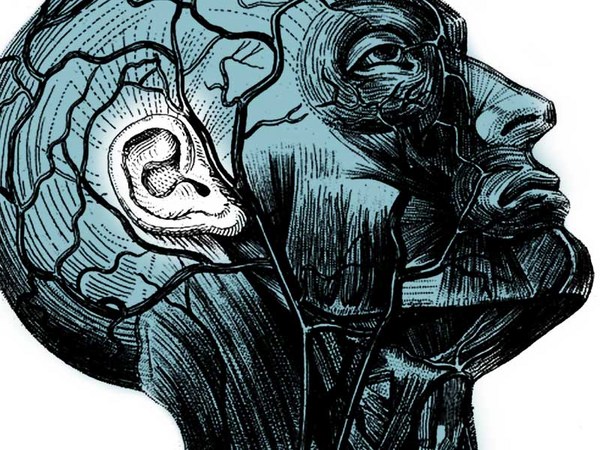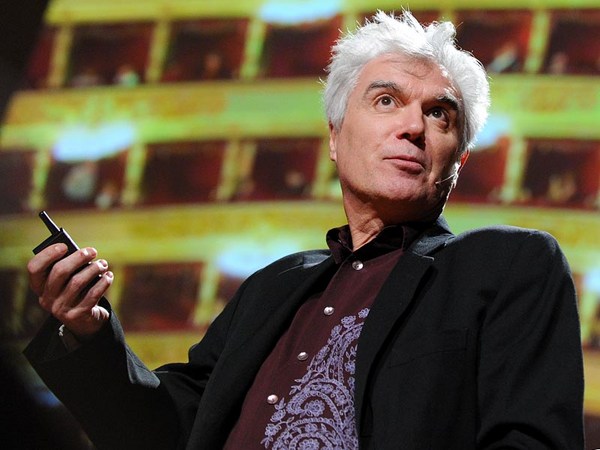Hello, everyone. It’s really nice to be here. And I guess my time starts now. Ladies and gentlemen, what you just heard was a piece of music. Now, that was what you hear, but this is what I hear. (Music - muffled version) This does not depict 100% accurately, but it's a rough image of what I hear. My name is Ammar and I am Deaf. Before I continue, I would like to take the time to appreciate and explain the beauty of this. This is Evelyn and she’s an interpreter. So basically, right now as I am speaking, my speech will be translated into subtitles for the deaf. So it’s exactly like how we watch subtitles on TV. Like, 'You’re beautiful.' No, 'You are beautiful!' Alright. (Laughter) Back to my story. I was born hearing like any baby until I was about two years old, I was hit by a high fever which affected my hearing. I had to wear hearing aids, which I hated so much because it was stuffy, it was not comfortable, and every single day, I took it out, I'll look at it. Is this all really inside me? So I don’t really wear them. And after school I’ll just remove them. Growing up with my parents seemed perfectly normal. Every weekends, I woke up to the vibration on the floor from my dad blasting music across the hall room. Bam, bam, bam. He never let me wake up peacefully, I don’t know why. (Laughter) So he would play from Bollywood, Latin, pop, hip hop, you name it. And you know in Bollywood, they have this little dance? Ache, ache, hey ... Yeah. I would always stand in front of the TV and imitate them, that's really how I started dancing. My dad exposed me to many things. At a young age, he would bring me out. And he would not just show me about music, but also about life. And because of this, I grew up in the hearing environment where everyone is speaking and everything was so noisy. I felt that this was normal. All this came to a change when I entered Canossian School for the Hearing Impaired. This was where I find that every student had the same disability as me. Everyone had hearing aids. Four years in that school, I realised that I was different from everyone despite having the same disability. My friends in school spoke differently from me. For example, true story, I’m not making this up or making fun of anybody but this is how it sounds: (Mimics voice) Yeah. So because of this, I start to feel that this is the discovery of the beauty of visual communication, which is sign language. A lot of the students were using them and had many facial expressions when communicating. So you could literally enter a class of 20 Deaf members inside a class, and it will all be silent, but then all the hands are moving. (Laughter) That's it. From there, I learned to be bilingual with Singapore Sign Language and also spoken English. I learned to embrace my deafness and understand that this is what it’s like to be in a Deaf world because I experience both worlds every single day. At the age of 17, I was in a mainstream secondary school, and that's where I took my passion in dance seriously. I had a small crew who shared the same passion as me, and every day at the last bell, we will go down to the foyer, throw our bags and start break dancing. We will ask each other, 'What's homework?' 'I don’t know!' And continue. And every single day, when a teacher ask me, 'Ammar, have you done your homework?' I will just be in a hip hop mode, 'Nah. Not cool.' Of course, being rebellious and everything, I ended up having to repeat my Secondary 3. Not a good example. So back then, when I started break dancing, music was played through phones - all those Nokia phones and all the S mini speaker, which is very, very soft. I’m not able to hear them. But I would always just stand back and look at my small crew there dancing, and they're like, 'Oh, that’s how really, hearing people can hear.' So what I would do? I would just stick the phone close to my ear, press it against me, and then I would feel all the music, and I would visualise it through the vibration of the music, and I would put it on my head and dance. I taught myself how to dance through YouTube tutorials. And those times YouTube did not have any setting whereby you could slow-mo the video or what. You could only pause and play. Frame by every frame. To this day, I still remember the very first dance that I learned from YouTube, which is from the late King of Pop, Michael Jackson. And this is how my first experience dancing really - Like, 'Whoa, I’m going to show this to my boys every day.' So, all I would do is, "Hey, [inaudible], look at this." You. You. Look at me now. (Laughter) So, that was when I realised that a body could do so much, and it could project out an emotion and expression. Come 2010, I came to watch a dance performance which changed my life. It grew my passion in dancing sky high. (Video; music) (Shouting) That was a calling to where I wanted to be. Now, what you saw are just probably dancers. But I didn't see that because what I saw from my audience seat - I saw a group of [dancers who are] deaf and hearing dancing together. And that was an instant connection that this is where I want to share my passion with them and share the same stage as them. And that's how I met Redeafination. Redeafination consists of both deaf and hearing members. And it was formed in 2008. And until today, we’re still deaf and dancing. Let's see, where am I now? (Laughter) So, what does it mean to be a deaf dancer? Deafness is not often associated with music, let alone dancing. And who says deaf can't appreciate music. Different deaf people have different hearing levels. In music, there are many layers of instruments. We have drums, guitar, piano. Some of us can hear bass; some can't hear the high notes. For me personally, I can’t hear the high pitch like a violin. So now, instead of hearing music, why not we learn to 'see' music? What do I mean? Allow me to do an experiment with everyone. If you guys would, I would like everyone to just stretch out your arms. And then, look straight, [so] your eyes don't move around. And then wiggle. Alright. Good. Now, this is what the average person can see. Now, slowly move back - make sure you don't tickle the other people. (Laughter) Move back this way, and wiggle them. And see, how much can you see your fingers wiggling without moving your eyeballs? Just here, and go wider and wider till you can’t see them. And until you can’t see them, that’s your maximum line of sight. In my crew, we were trained to improve our sense of sight by widening our field of vision. Since we can’t depend on our sense of hearing, we listen with our eyes. So with this as a size, imagine the world if we could be a better communicator by listening with our eyes, and not just our ears. What if we could have a better awareness of our surrounding and avoid certain bad situation? Most of the time, we humans we see, but we do not observe. Imagine a scenario where I am performing with another dancer. I am kneeling down, my face down. I am not sure what’s happening here. But I am aware of what I am seeing. I have no cue, I don’t know when I'm going to perform, but through this, I'm able to know that - okay, I can see that this guy, he's going to end his performance soon. And I anticipate it. And that’s when I know when I'm going to execute my movement. So this allows me to see the timing of the dance. Through this, we also apply this in my crew whenever we perform outside. You see, whenever we are having a dance practice in a dance studio, we are always in our own comfort zone. We have four walls, a mirror in front of us. It feels good. We are used to it. Now, put us into a stage, it's a whole different ball game. The four walls will be spread out. The mirrors will become you. And the music will be loud, but then because the music will be projected outwards, we won’t be able to hear the music 100% clearly. And all the echos will just mess up our frequency. This is the part where we start to listen with our eyes. And people often ask, 'How do you guys synchronise?' It could be easy. Imagine there’s five of us here, and we are performing, we are dancing. So, without turning left or right, I'm able to know that all these people here are dancing together with me. Because we have the rhythm, and we are aware of our surrounding and we take control of the situation. For the audience, they might see that we are actually dancing with the music - la la la la la la la - but for us, we are actually counting. 1 ... 2 ... 3 ... 4 ... Now, why is it that we learn to see music? Because we have music, right? There are many genres in music. We have jazz, pop, and the rest. In each genre, we have a different dance style and a different character. Hip hop is all about the swag or the groove move, or about being cool. Ballet is all about being elegant, graceful. So, we - If you guys notice that we - Just by me doing all these movements, we see it, we don’t have to hear it. You know that this action is a ballet movement. It is soft. And this is hip hop - kick here, point there, pause, and everything. So, Redeafination, we don’t just learn hip hop itself, we also expose ourselves to other genres so as to understand the importance of its own culture and history in general. This is to also explore the texture in dance, whether it is heavy or a light movement. I took up dance classes outside because I didn’t want myself to be in a comfort zone for too long. So being outside, where I took up dance classes, there’ll be a hearing instructor teaching. And this is a bit scary because I didn’t know what was going on. Everyone was just (Djjjj ...) Okay, I don’t know where to look at. The instructor will just be talking, I’m either too far at the back and I don’t know what’s going on there. It was just like - she was desperate. And the next thing I know is, '5, 6, 7, 8!' Everything is going very fast. So basically I’m dancing blind. I have no theory of the dance step. I have no idea what the history or the meaning or the name of the step. I wouldn't have known that this is Bart Simpson. Back in my crew, we have claps for cue. We slow down and exaggerate each movement. Visual. So whenever we are having dance practice, we have '5, 6, 7, 8, and ...' You will see this rhythm, and you will know when to keep up. But in a hearing class, they will just say '5, 6, 7, 8!' step, step, step, step. step, step. Step, step, step, step. It’s a lot for me. And I think that being a deaf dancer in a hearing crew is tough. Because like I said earlier, I'm very distracted with everything, and I also do not have access to details of the dance steps. I believe that as dancer, when you dance with the knowledge of the movement, you can only then embrace the dance. And you could be a better performer. And dancing evokes an emotion. A character. And we as dancers, we have a responsibility to portray it. So I always make it a point that whenever I teach my crew, they don’t just simply dance. They learn the history of it, the origin of how this dance came about. For instance, this is the Harlem Shake. And where the origin came from? Of course, Harlem. So, to end my talk, I would like to do a final experiment with all of you. I have asked the TEDx crew to play one random song for me. When the music plays, I want all of you to not just hear with your ears, but your eyes, body, skin, hair, heart, or even your feet. So if you can feel the vibration through the floor, then that will be a bonus. I don't know the genre, but I know that it's going to be hip hop. And when I feel the sense of the beat, let’s see what I can create. And if you feel like dancing with me, go ahead. Let's start the music. (Music) Alright. (Cheers) (Applause) Thank you for listening with me. And before I go, I want to say that I am Ammar, and if everyone can look past the ability to hear or not hear, I think the world will be a better place to stay, and that the two worlds will be more united. Thank you. (Applause)
